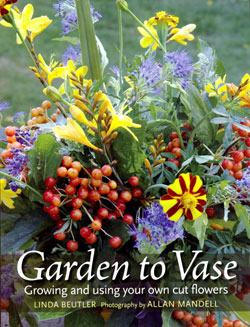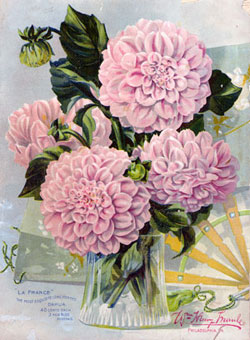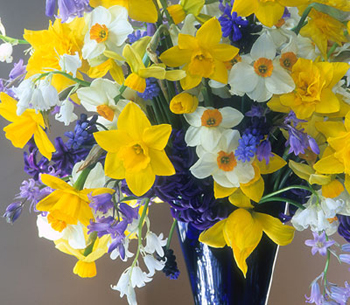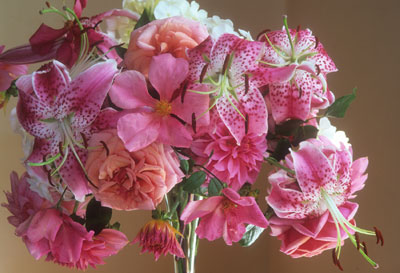Heirloom Bulbs as Cut-Flowers: Expert Tips from Garden to Vase
A freshly picked bouquet can brighten up any room — or day — and many heirloom bulbs make fabulous cut flowers. To keep them looking their best as long as possible, here are some easy, expert tips from Garden to Vase: Growing and Using Your Own Cut Flowers by our good customer Linda Beutler.
An avid gardener and professional florist, Linda offers all sorts of terrific, first-hand advice in her funny, encouraging, down-to-earth guide. And she goes way beyond the technical, offering tips for collecting vases, using plants you might never think of putting in a bouquet, and making cut flowers an everyday pleasure in your home.
We hope you’ll buy her book! It covers a LOT more than bulb flowers, it’s full of gorgeous photographs by Allan Mandell, and we’re sure you’ll find it — as we have — both useful and inspiring.
Jump to Bulb-by-Bulb Specifics
Fundamentals for Longer-Lasting Bouquets

Pick Early or Late
“Morning, and the earlier the better, is the best time to pick flowers. The plants have had all night to rest from the work of photosynthesis (food making) that occupies them all day. . . . The roots have spent the night drawing water up . . . so that by sunrise the leaves, flowers, and fruit are as fully hydrated as it is possible for them to be. Without the stimulation of sunshine, plant breathing, known as transpiration, slows. . . .
“Once the sun comes up and the sky grows light, a plant’s metabolism kicks into high gear. . . . Plants, like animals, give off moisture, and just as we sweat on a hot day, plants give off water vapor in the heat. The sun dries the air, and . . . the plant cannot drink water from the soil fast enough to replace what it is losing. . . .
“Evening is the second best time to pick flowers. The light is less direct, the air is starting to cool, and plants are regaining their water and carbohydrate balance.”
Use Sharp, Clean Tools
“The vascular system of plants . . . is a fragile bundle of tubular cells, easily mashed and plugged,” Linda writes. “Once a flower stem is plugged, it stays that way, and leaves and petals served by that blocked section . . . start to die. The only way to remove the obstruction is to recut the stem. . . . Using sharp tools . . . means that each cut will be as clean as possible.
“The best clippers (also called secateurs) have pass-by blades, both equally sharp, that slide past each other as they cut through a stem.” Linda prefers those with “slender, straight, needle-nosed blades.”
For knives, she recommends “straight or curve-bladed grafting knives” though any sharp knife will do, as long as it’s not serrated. “Serrated knives have no place in the floral tool kit. Their cuts always create unwanted debris.”
“Cleanliness is next to freshness when it comes to your tools. . . . Rinse your harvesting tools with water every few minutes, to keep hinges and blades from becoming gummy. Using a mild bleach solution is fine for this purpose, nine parts water to one part chlorine bleach.”

1897 Maule’s catalog, Philadelphia
Cut Stems at an Angle
What Linda calls “the single most important factor in flower longevity” is also one of the easiest: cutting stems at an angle. As she explains, “This bias cut exposes more of the stem’s vascular system to water than a flat or blunt cut does. Also, should a flat-cut stem rest on the flat bottom of a vase, it cannot take up water. It is simply sucking on the bottom of the vase. If the same stem is cut at an angle, only the point rests on the bottom, and the rest of the cut surface is able to draw water.”
Plunge, Clean, Soak
“As you go out into your garden to harvest flowers, it is best to take a bucket of fresh water with you” and plunge stems into it as soon as you cut them.
When you get back inside, trim and clean the flowers you’ve picked, “removing spent flowers . . ., stripping away foliage that would be underwater . . . , and giving each stem a fresh sharp cut at an angle.”
Then Linda recommends something we’re usually too impatient to do: “Take the bucket to a cool dark place where they can sit for several hours, or overnight, to recover from the trauma of being harvested. . . . At this point, you want the flowers to concentrate, to the best of their feeble abilities, on figuring out how to drink water with a stem instead of with roots.”
For Most Bulbs, Skip the Preservative
Changing the water in a vase every two or three days will help any bouquet last longer. Floral preservative, on the other hand, is not something Linda usually recommends for bulb flowers since most “do not respond well to sugar in their water.” (Exceptions are noted below). Although special low-sugar preservatives are available, “after years of reading science experiment reports from my students, it is clear to me that maintaining clean water and high levels in containers . . . are the real keys to flower arrangement longevity.”
Bulb-by-Bulb Specifics
Allium
“Harvest allium when the flower head is one-third to one-half open. Dry immediately or use fresh. Because allium will make the water smell like you live in a diner featuring grilled onions, change the water daily or use floral preservative to suppress the odor. Keeping the water clean is key to longevity for all alliums. Vase life ranges from ten days to three weeks.”
Crocosmia, Montbretia
“Harvest when the first two or three florets are open. Buds showing color may open if the water is kept fresh. Stems last about a week. . . . The seedpods are also attractive and dry well.”
Cyclamen
“You would not think it, but the fragile-looking flowers of cyclamen . . . make cut flowers of surprising endurance. The mottled and patterned leaves . . . are equally tough. . . . To harvest either flowers or foliage, tug the stem base away from the corm, thus stimulating new growth. Do not cut the stems from the plant. The stumps left behind serve as a conduit for disease organisms to enter the corm, but tugging the flower (or leaf) leaves a wound right on the corm that seals over quickly and lets the corm know it needs to produce a new bud.”
Daffodils

with bluebells and grape hyacinths
in a bouquet by the amazing Suzanne Lewis
“Narcissus buds emerge from the ground pointing up and will turn to a 90-degree angle just as they start to open, and this is when they should be picked. Buds harvested too early may not develop. . . .
“How long any narcissus lasts in a vase is dependent on how it is conditioned. The rinsing process described [below] is essential to the success of this genus as cut flowers. All narcissus have a thick clear sap, the consistency of heavy syrup, that is sour and unpleasant to taste, and mildly toxic. . . . The rinsing process washes away the running sap, prevents the stem’s xylem from drinking this poisonous substance, and allows the cut stem to hydrate properly. Rinsing enables us to use narcissus in arrangements with any other type of flower, including those, like tulips, that would otherwise be sensitive to the toxic sap. . . .
“Before harvesting . . . , half-fill two buckets of water. . . . As you pick them, place all of the freshly cut flowers into one of the buckets. . . . When you are all done, pick up the entire bunch of flowers and immediately place them into the second bucket. Let them sit for fifteen to twenty minutes. While they are sitting with their nasty sap seeping out, clean the first bucket and half fill it with more water. At the end of this waiting period, lift the bunch of flowers out of their bucket and examine the cut ends. If they are still oozing . . . , place the entire bunch into the bucket of fresh water you have prepared, without recutting the stems.
“This should be a quick process: out of one bucket, quickly look at the cut ends, and, if necessary, put them into the fresh bucket immediately. . . . Repeat the rinsing process — fresh water, wait, examine — until the stems lifted out of the water stop losing sap. Usually it only takes two changes of water to staunch the flow. . . .”
“The overall vase life should be ten days if the flowers are purchased or harvested at the right stage and properly conditioned. If you buy daffodils in full bloom, expect a much-diminished show.”
Dahlias
Here at Old House Gardens our dahlias last plenty long in bouquets without any special conditioning, but for even longer vase-life, here’s what Linda recommends. If you try it, we think you’ll find it’s easier than it sounds at first!
“At harvest time, prepare a vat of hot water (160°F is optimal) with floral preservative dissolved in it. Cut the dahlias to the length you want, wrap the flowers loosely in newspaper to protect them from hot water vapor, and dip the cut ends into the water (to 3 inches deep) for twenty seconds. This can be done in bunches of five to ten stems at a time. Remove the stems from the hot water and immediately plunge into a bucket of cool deep water, removing the paper around the flowers. Leave the dahlias in cool water until you are ready to use them. They should last five to seven days if properly conditioned first.”
Freesia
“Harvest freesia when the first bud has just opened or is about to. The side branches do not develop once the stem is cut, so I remove them. The entire freesia stem will bloom for more than ten days, but the primary flower or two may need to be removed or they will detract from the newly opened florets. Using floral preservative helps tight buds open with well-developed color.”
G. callianthus, Abyssinian Gladiolus
“Each slender stem has more than a dozen flower buds, which open from bottom to top. Best to harvest when the first one or two flowers are open. The flower stalks elongate as each blossom matures; you will want to take the spent flowers off as the upper buds open to keep the stem looking smart. The entire stem, assuming you change the water and recut the stem every day or two, should last nearly two weeks.”
Grape Hyacinths, Muscari
“Grape hyacinth is too fragile to insert into foam. It lasts in water about a week, if picked when the bottom third of the little bells have opened. Maintain fresh water, as this little guy is a heaver drinker.”
Hyacinths
“Pick hyacinths when all florets are showing color; the stem will get taller and the florets enlarge. . . . Harvest by cutting the leafless flower stem with as much length as possible; do not damage the surrounding foliage. Note that the sap can be irritating. Place in water, allowing the stems to sit slightly chilled or at room temperature for an hour or two before using. Vase life in fresh water is more than seven days. No floral foam.”
Iris
“Bearded iris can be picked anytime after the primary flower is showing good color and starting to unfurl. All of the other buds showing even a nose of color will eventually open if overall stem health is maintained by good water hygiene. Each flower lasts only three days, but removal of spent flowers encourages the remaining buds to open, and we can then get more than ten days’ enjoyment from a single stem. . . .
“Try not to damage nonflowering foliage as you harvest. The strappy, grasslike leaves are needed for producing nutrients for the rhizomes.”
Lilies, Lilium
“Harvest lilies when the buds are showing color and just starting to ‘crack,’ meaning the sepals are starting to separate from each other. “When harvesting lilies, a gardener needs to decide whether the plant will be treated as an annual, in which case the whole length of the stem can be cut to the ground, or as an herbaceous perennial,

photographer Suzanne Lewis, with ‘Rubrum’ lilies,
‘Jersey’s Beauty’ dahlias, and roses
when only half of the stem length should be taken. Lilies you expect to return to the garden year after year need the leaves on the stem to continue creating food for the bulb even after the flowers have been removed.
“Once the stem has been cut, only the leaves that would be underwater should be removed. The upper leaves remaining on the stem will provide nutrients for the unopened flower buds and will help them mature normally as the cut stem ages. . . .
“Each open blossom should last at least four to five days, and new buds will be opening as the older flowers fade. The entire stem can last for more than two weeks, as long as the water is kept fresh. Removing the anthers increases longevity and prevents the pollen from staining the flowers or anything else.”
Here at Old House Gardens, we think anthers add so much to the beauty of lilies that we rarely remove them. If the pollen gets on your clothes or a tablecloth, you can easily prevent it from staining by simply laying the dry cloth outdoors in the sun for a few hours. Like magic, the pollen disappears! Unfortunately, if you don’t notice it till after you launder the cloth, this technique won’t work.
Peonies
“Harvest peony in the ‘soft marshmallow’ stage, when the first petal or two is emerging from the calyx and the bud is soft when you squeeze it. If you have cold storage, peonies can be stored for weeks before they are needed. Remove only the leaves that would be underwater. If picked at the right stage, peony will last over a week in water or foam. . . .
“When harvesting your peonies, be mindful of the plant’s future. Do not take away more than half of the total number of flower stems at full length. It is okay to cut the flowers from the remaining stems, just leave the foliage. . . .
“Peonies dry beautifully. Harvest them for drying when they are half to just fully open. Make small bunches and hang them in a warm dark place. The natural color of the flower will darken a few shades, making the burgundys nearly black. If the flower has been open too long, it will shatter when you dry it.”
Snowdrops, Galanthus
“This dainty flower, dangling as it does from a fine pendant pedicel, is longer lasting when cut than you might expect. In a cool room, short vases full of snowdrops will last more than a week if they are harvested when they first spread their outer petals. No floral foam.”
Snowflakes, Leucojum aestivum
“Harvest when the first two florets are open. Summer snowflake lasts seven to ten days in water, but the stems are too soft to insert into standard floral foam. All buds will develop if the water is changed regularly, although the earliest floret may need to be removed while the youngest florets are opening. The clear sap is not toxic to other flowers.”
Tulips
“Unlike almost all other cut flowers, tulips continue to grow after they have been cut — if you do not believe me, see for yourself. Most will grow at least 1½ inches after they have been arranged in a vase. Tulips are highly phototropic; like sunflowers, they strive to face the strongest source of light as long as their stems are able to bend toward it. This makes them delightfully unruly, nearly lawless, and irresistible.
“Tulips should be harvested (or purchased) while the flowers are still predominately green, with just their edges touched with enough color to give you a clue of what is coming. . . .
“Tulips do not require floral preservative, although they are not harmed by it except in high concentrations. A leaf or two left on the upper part of the stem will produce enough sugar to help the flower open properly and attain its maximum color saturation. . . .
“To start with, cut the tulips in such a way that they seem too short. They are going to grow perhaps two more inches, so if you leave them too long at the start, they will get floppier sooner. By the next day, these tulips will look more in proportion in their array, and they will have turned to find the strongest light source in the room, either a reflective white wall or a window. It is what they do, and no hocus-pocus will stop them.
“Over the days the tulips will ripen their color and continue to grow, eventually opening their flowers flat during the day and closing up at night. The petals will enlarge, and finally the whole flower will be too big for the stem to hold up; then the tulips will start to drape in a languid, “We don’t care anymore,” Greta Garbo kind of way. The petals will no longer close at night, and the flower will finally fall apart. From a newly purchased or harvested bunch of still-green tulips to shattering flowers will be a ten-day journey. Enjoy the ride.”
Back to Fundamentals Back to Bulb Specifics Buy Linda’s Book












